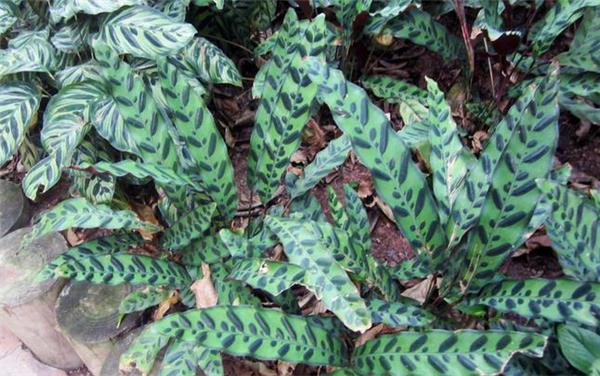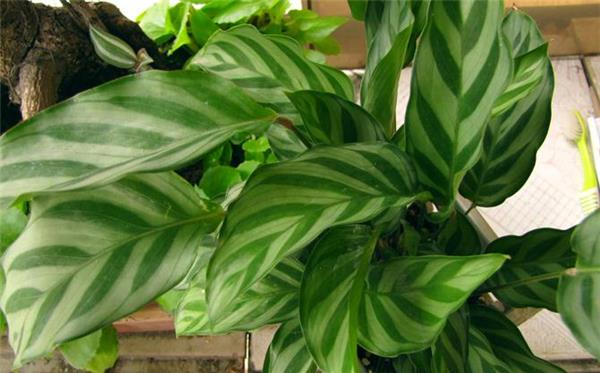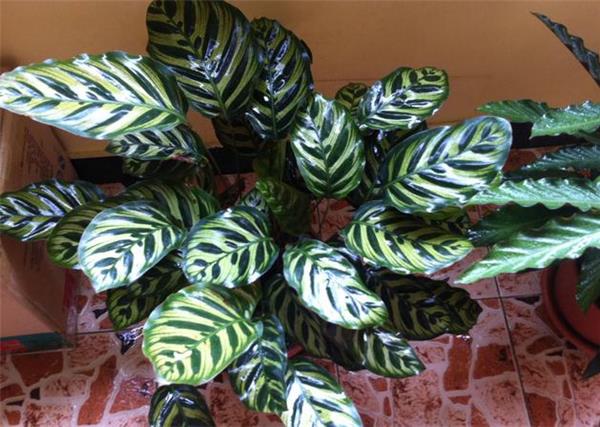Is it poisonous for peacock arrowroot?
Many friends like to raise peacocks indoors, so that they can purify the air. So, is peacock taro poisonous? Maybe some friends don't know much about this, so let's take a look at it together.

What is peacock bamboo taro?
Peacock bamboo taro, a perennial herb up to 60 cm high, has rhizomes, long and narrow spear-shaped leaves grow directly from the roots, and the plants are tufted; there are different shades of green markings on the leaves, and the back of the leaves are mostly brownish red. The leaves of this species are silver-green with dark green spots from the midrib and brownish-red spots of the same shape on the back. The formaldehyde removal efficiency of peacock bamboo taro is half of that of orchid, but it is also much higher than that of ordinary plants. in addition, it is also an expert in removing ammonia pollution in the air.
Growth habits of Peacock Bamboo Taro
Peacock bamboo taro prefers semi-shade, is not resistant to direct sunlight, and adapts to growing in a warm and humid environment. The cultivation should be shaded to a certain extent, and the temperature should be kept at about 12 ℃, and the temperature in winter should be maintained at 16 ℃. The growth is exuberant in spring and summer, which requires higher air humidity and can be sprayed. The soil is not very strict, but it is required to keep moderately moist. In the growing season, fertilizer is applied once every two weeks, while the soil can be slightly dry and cool in winter, and the number of fertilization can be reduced.

Is the peacock taro poisonous?
Peacock bamboo taro is non-toxic and beautiful in shape. it is a favorite variety in home decoration flowers. Its efficiency of removing formaldehyde is half of that of Cymbidium, but it is also much higher than that of ordinary plants. in addition, it is also a master at cleaning up ammonia pollution in the air. This kind of plant is very ornamental and can purify the air.
The method of culturing Peacock and Taro
Pot cultivation of peacock bamboo taro should use loose, fertile, well-drained, humus-rich slightly acidic loam, generally can be mixed with 3 parts of rotten leaf soil, 1 part of peat or sawdust, 1 part of sand, and add a small amount of bean cake as base fertilizer, avoid heavy and sticky garden soil. When putting on the basin, the bottom of the basin is first padded with 3 inch thick coarse sand as a drainage layer to facilitate drainage.
Adequate moisture should be given during the growing period, especially in summer and autumn, in addition to keeping the basin soil moist, it is also necessary to spray water to the leaves to cool and moisturize; it requires a higher air humidity, preferably up to 70% to 80%. Avoid dry air and dry soil, but do not accumulate water. Moisture should be controlled after the end of autumn in order to resist cold and survive the winter. Keep the dry environment in winter, if it is too wet, the basal leaves will be yellow and scorched, which will affect its ornamental value.

Matters needing attention in Culture of Peacock Bamboo Taro
Peacock bamboo taro likes high temperature and humid air, and grows fastest when it is more than 20 ℃. In the low temperature season from October to April of the following year, the north should move into the greenhouse to overwinter, and the winter overwintering temperature should not be lower than 15 ℃, otherwise the leaves are dark, the leaves curl and the leaf tips are yellow. if the freezing is slight, the environmental conditions can be changed in time, and new leaves can still be sent out in the coming spring. If the leaves are severely frozen, they die one after another, or even the whole plant dies.
Plant peacock taro if the indoor temperature difference between day and night can be covered with plastic film or insulated and moisturized with glass box, and wash the leaves with warm water once a month to maintain the color of the leaves. Every spring, when the temperature rises steadily to 20 ℃, the pot can be changed once. When changing the pot, new culture soil should be added, and the residual roots and leaves should be cut off and replanted to facilitate growth.

This is the end of the introduction of peacock taro. I believe that after reading it, we will have a certain understanding of peacock taro. If there are friends who want to raise peacocks and taro indoors, you can refer to the relevant knowledge I introduce to you.
Related
- Wuhan Hospital Iron Tree Blooming Result Was Instantly Frightened by the Gardener Master
- Which variety of camellia is the most fragrant and best? Which one do you like best?
- What is the small blue coat, the breeding methods and matters needing attention of the succulent plant
- Dormancy time and maintenance management of succulent plants during dormancy
- Minas succulent how to raise, Minas succulent plant pictures
- What are the varieties of winter succulent plants
- How to raise succulent plants in twelve rolls? let's take a look at some experience of breeding twelve rolls.
- Attention should be paid to water control for succulent plants during dormant period (winter and summer)
- Watering experience of twelve rolls of succulent plants
- Techniques for fertilizing succulent plants. An article will let you know how to fertilize succulent plants.



